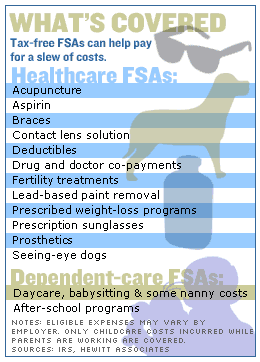NEW YORK (CNN/Money) -
In the next month or so, you're going to have a chance to save yourself some serious money in 2005.
Open enrollment season is here -- the time your employer gives you to select your benefits for next year. Besides picking the insurance plans you want, you may be given the option to fund a flexible spending account (FSA) using pre-tax dollars deducted from your paycheck.
The money you put into an FSA may be used to pay for medical, vision and dental expenses not covered by insurance, including everything from acupuncture to prescription sunglasses to deductibles and co-pays for prescriptions and doctor visits.
You also may have the option to fund a dependent-care FSA, which will help alleviate your childcare costs.
A one-income family of four earning $100,000 would save roughly $1,300 a year in federal taxes by contributing $5,000 to an FSA for healthcare, said enrolled tax agent David Mellem of Ashwaubenon Tax Professionals. They'd save another $1,300 if they did the same with an FSA for dependent care.
A two-income family of four making $100,000, with each spouse earning less than $87,900, would save approximately $1,600 a year for a $5,000 healthcare FSA. If they also used a $5,000 dependent care FSA, that would save them another $1,600.
FSAs can save you even more in taxes than your pre-tax 401(k) contributions, Mellem said. That's because they are exempt not only from income tax but also from Social Security and Medicare taxes.
Count your chickens
To make the best use of a flexible-spending account, keep in mind that it operates under a use-it or lose-it policy. So if you don't incur costs in 2005 equal to the dollars you contributed, you'll lose what remains in your account.

So estimate how much you'll have in out-of-pocket costs next year, including deductibles. Unless you're having a baby or anticipate new medical expenses, you can use your out-of-pocket costs this year as a guideline.
"It's a gamble for you to try to figure out what is going to happen," Mellem said. "Put away what you know you will have. Then put away a little more just to be safe."
You may be very happy you did given the expanding list of expenses eligible for reimbursement.
Last year, the IRS added some non-prescription drugs such as cold medicine and cough syrup to its list of reimbursable items for healthcare FSAs.
But the list also includes some non-traditional medical and dental expenses, such as laser eye surgery, fertility treatments, inpatient drug rehab, lead-based paint removal and osteopathic care.
FSAs also come in handy if you want to get new eyeglass frames, contact lenses or even contact lens solution.
A weight loss program (minus the cost of meals) may also be covered if your doctor prescribes it as part of a treatment plan for a specific disease such as hypertension, heart disease or obesity.
Smokers, however, can enroll in a smoking cessation program without their doctor's approval because the government recognizes smoking as an addiction.
You can even deduct 14 cents a mile for medical-related trips, such as for doctors' appointments or to pick up prescriptions.
"I wish that Hewitt had a higher limit," joked Andy Anderson, an attorney who works for the human resources consulting firm. "When you throw in braces and glasses, I cannot ever think of a time when I had to leave money in the FSA."
How much can you put away?
Your company limits how much you can set aside in a healthcare FSA. Typically it's between $2,000 and $5,000 a year. And it may restrict which IRS-approved expenses are eligible for reimbursement.
The federal limit on dependent care FSAs, meanwhile, is $5,000 per family. That may reduce any child tax credit you wish to claim on your federal tax return. Families earning $43,000 a year or more may want to consult with a tax professional to determine which option, if not both, may be best for them. Those making less than $43,000 may fare better just using the tax credit, said John W. Roth, an analyst at tax information publisher CCH Inc.
Even though you contribute to FSAs gradually via regular payroll deductions throughout the year, you're allowed to spend the full amount on medical or dependent care costs as early as Jan. 1.
So if you have $750 in out-of-pocket dental expenses in February, you will be reimbursed soon after even if you don't yet have that amount in your FSA.

|

